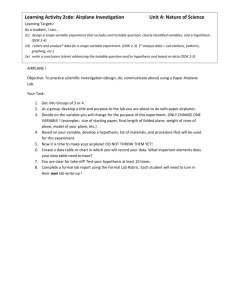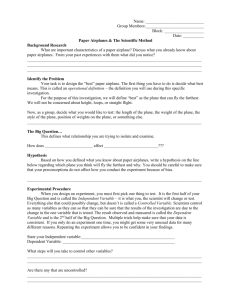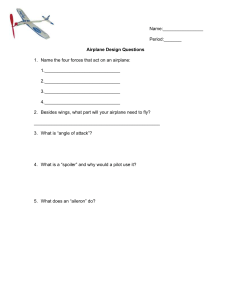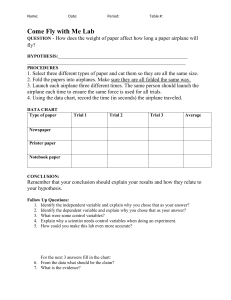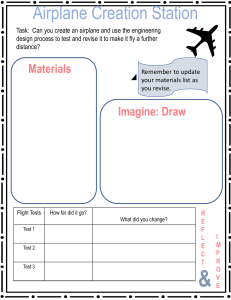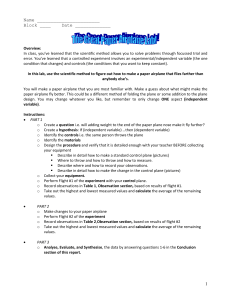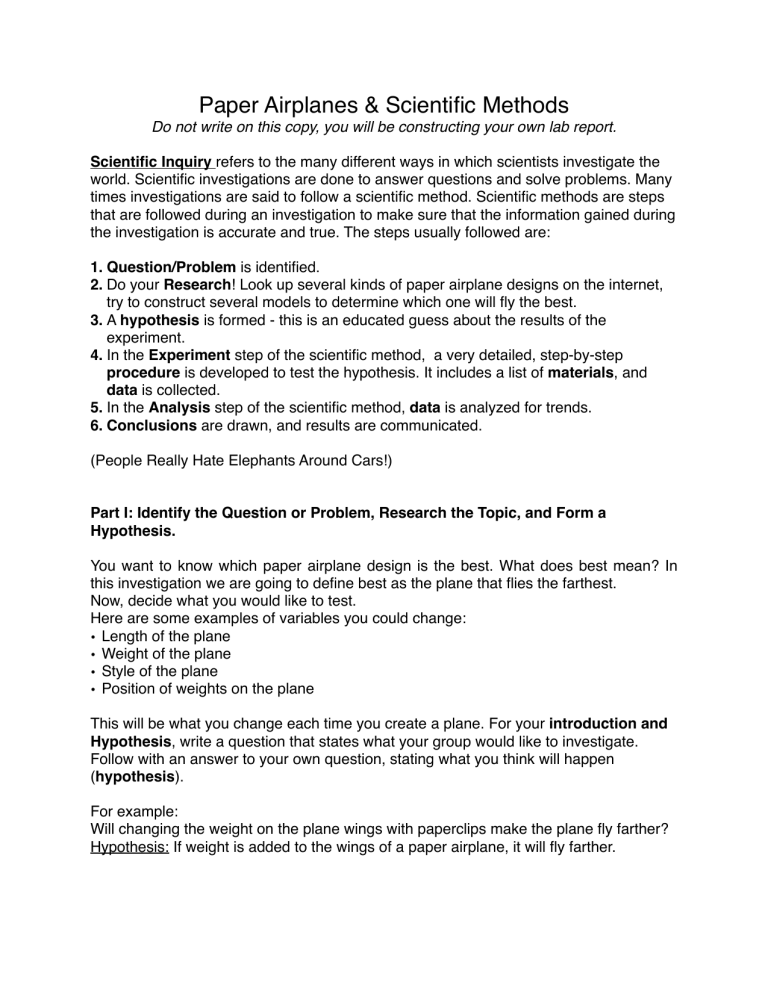
Paper Airplanes & Scientific Methods Do not write on this copy, you will be constructing your own lab report. Scientific Inquiry refers to the many different ways in which scientists investigate the world. Scientific investigations are done to answer questions and solve problems. Many times investigations are said to follow a scientific method. Scientific methods are steps that are followed during an investigation to make sure that the information gained during the investigation is accurate and true. The steps usually followed are: 1. Question/Problem is identified. 2. Do your Research! Look up several kinds of paper airplane designs on the internet, try to construct several models to determine which one will fly the best. 3. A hypothesis is formed - this is an educated guess about the results of the experiment. 4. In the Experiment step of the scientific method, a very detailed, step-by-step procedure is developed to test the hypothesis. It includes a list of materials, and data is collected. 5. In the Analysis step of the scientific method, data is analyzed for trends. 6. Conclusions are drawn, and results are communicated. (People Really Hate Elephants Around Cars!) Part I: Identify the Question or Problem, Research the Topic, and Form a Hypothesis. You want to know which paper airplane design is the best. What does best mean? In this investigation we are going to define best as the plane that flies the farthest. Now, decide what you would like to test. Here are some examples of variables you could change: • Length of the plane • Weight of the plane • Style of the plane • Position of weights on the plane This will be what you change each time you create a plane. For your introduction and Hypothesis, write a question that states what your group would like to investigate. Follow with an answer to your own question, stating what you think will happen (hypothesis). For example: Will changing the weight on the plane wings with paperclips make the plane fly farther? Hypothesis: If weight is added to the wings of a paper airplane, it will fly farther. Part II: Write a Procedure When you design an experiment, you must first pick one thing to test: the length, the weight, position of weights, style, etc. This is called the Independent variable, the thing you change or test. Everything else that could possibly change, but doesn’t, are controlled variables. Scientists control all the variables they can so they can be sure that the results of the investigation are due to the change in the one variable that is tested. You must decide what kind of data you will collect or what you will observe or measure. This is called the dependent variable. You need to repeat the experiment several times, these are called trials. Multiple trials help make sure that your data is consistent. If you only do an experiment one time, your data may be skewed without any other data to compare it to. A list of materials is also needed so that other scientists can repeat your experiment. The procedure for this investigation is partially done for you. Add any extra steps needed for your investigation. Here is a sample procedure: 1. Select 3 different paper airplanes a. b. c. 2. Pick a spot to launch the planes each time 3. Throw the first airplane 4. Measure the distance the airplane went, keeping in mind your starting position 5. Record the data. 6. Repeat 4 more times 7. Repeat for all three airplanes Part III: Collect & Record Data The dependent variable is the data you collect. Data is frequently recorded in some type of chart or table. The chart has a place to record measurements and a place to show averages or other statistics. You will use a chart that looks like this: Type of Airplane Trial 1 Trial 2 Trial 3 Trial 4 Trial 4 Average Plane One Plane Two Plane Three Part IV: Analyze Data After your data is collected and recorded, you must analyze the data. You must be careful to look for patterns, trends, and relationships. Making a graph is a good way to help analyze data. A graph makes a picture of the data and can help you visualize the patterns, trends, and relationships. It is very important to use the right kind of graph when analyzing data. In this investigation, you compared different kinds of paper airplanes. For this experiment, a bar graph is the best choice. All graphs have some things in common: • The independent variable is on the X-axis • The dependent variable is on the Y-axis • Each axis is labeled to identify the variables • Units of measurement are included in the labels • The graph has a descriptive title • The information on the graph is spread out so that most of the graph is used Helpful Tips: • The length of one floor tile is 1foot. While the science department strictly uses the metric system, we can use the standard measurement system since we are only comparing which airplane flies farther in comparison to another airplane. • Do your research! Look up many different styles, and try to make a few different airplanes. • Each student will complete separate lab reports, but make sure your lab report has ALL partners’ names on it, in order to receive full credit. • Lab reports should not contain pronouns: I, me, we, she, they. • Lab reports should be written in a technical writing style known as passive tense. DO NOT WRITE: We threw the airplane and it traveled a length of 32 floor tiles. DO WRITE: The airplane was thrown and it traveled a length of 32 floor tiles. • Make sure your graphs are labeled, with units!
